Ever tried to plant a lavender hedge and ended up with a tangled mess? Well, you’re not alone! The key to getting it right lies in the Lavender Hedge Spacing. Trust me, I’ve been there, done that, and got my hands dirty enough times to know.
In my early gardening days, I was all about cramming as many plants as possible into every inch of soil. But let’s just say my lavender hedges weren’t exactly thriving. It was only when I learned about the importance of proper spacing that my garden truly started to bloom. So stick around for some handy tips and tricks! “Keep reading about Lavender Hedge Spacing (The Definitive Guide)”
Key Takeaways
- Lavender hedges should be spaced 12 to 18 inches apart for smaller varieties, and 24 to 36 inches for larger ones.
- Proper spacing is crucial for air circulation, preventing disease, and allowing room for growth.
- Overcrowding can lead to poor health and reduced blooming.
- The type of lavender (English, French, Spanish) also influences the ideal spacing.
- Regular pruning helps maintain shape and promotes healthy growth.
What is Lavender Hedge Spacing?
When we talk about Lavender Hedge Spacing, we’re referring to the distance between individual lavender plants when setting up a hedge. This isn’t just a random guesswork, folks! It’s an essential part of gardening and landscaping.
Importance of Proper Spacing
Now, why should you care about proper lavender hedge spacing? Well, for starters, it plays a vital role in ensuring healthy growth for your lavender plants. Too close and they might compete for resources; too far and your hedge might look sparse.
But that’s not all! The right plant distance also contributes to the aesthetic appeal of your garden. A well-spaced lavender hedge can be a real showstopper, adding structure and color to your garden layout.
Factors Influencing Lavender Hedge Spacing
So what determines the ideal lavender hedge distance? Several factors come into play here. The size of the lavender variety you’re planting is one biggie. Larger varieties need more room than their smaller cousins.
Next up are soil conditions. Lavenders love well-drained soil, so if your ground tends to hold water, wider spacing can help prevent root rot. Sunlight requirements are another consideration – lavenders need plenty of sun, so don’t crowd them!
Last but not least, consider the climate impact on spacing. In cooler climates where growth is slower, you might want to plant closer together for a fuller effect sooner.
Understanding Different Types of Lavender
When it comes to lavender hedge spacing, the type of lavender you’re dealing with matters a lot. There are three main lavender varieties that garden enthusiasts swear by – English, French, and Spanish. Each has unique characteristics that directly impact how you should space your lavender hedge.
English Lavender
First off, we have the English Lavender. This variety is known for its compact growth habits and moderate mature size. The typical height for an English lavender plant is around 1-2 feet tall, with a similar spread. Now, when it comes to hedge spacing for English lavender, you’d want to keep these plants about 3 feet apart from each other. This allows enough room for the plants to grow and flourish without overcrowding each other.
French Lavender
Next up is French Lavender. This variety is slightly larger than its English counterpart, often reaching heights of 2-3 feet with a spread of up to 4 feet wide. Because of their larger size and more expansive growth patterns, hedge spacing for French lavender needs a bit more elbow room – about 4 feet between plants should do the trick.
Spanish Lavender
Last but not least, we’ve got Spanish Lavender. These guys are a bit more compact than the French variety but taller than the English ones. They usually grow to be about 2 feet tall and wide. When planning your lavender hedge spacing for this variety, aim for about 3-4 feet apart depending on how dense you want your hedge to be.
How to Determine Optimal Spacing for Your Lavender Hedge
Determining the right lavender hedge spacing is crucial. It’s a bit like Goldilocks, not too close, not too far, but just right. Factors such as the available garden space and the mature size of your lavender plants play a significant role.
Assessing Your Garden Space
First things first, let’s talk about garden space evaluation. You gotta know what you’re working with here.
So grab that tape measure and start measuring your garden for the lavender hedge. This will help you figure out how many plants you can fit in without them feeling all squished up.
Remember, lavenders need their personal space too! So make sure your garden capacity is suitable for a lavender hedge before going all in.
Considering the Mature Size of the Plant
Now let’s chat about lavender plant mature size. These beauties can grow quite big, so it’s essential to consider their full-grown dimensions when planning your hedge.
You see, accounting for plant growth in spacing isn’t just about giving them room to grow. It also ensures they won’t end up fighting over sunlight or nutrients.
Understanding lavender growth patterns will help you nail that optimal lavender hedge spacing, ensuring each plant has enough room to flourish into its full potential.
Techniques for Measuring and Marking Out Spacing
When it comes to lavender hedge spacing, precision is the name of the game. Accurate spacing ensures your lavender hedges grow evenly, maximizing their aesthetic appeal and health. Two common methods can help you achieve this: using a tape measure and employing a grid system.
Using a Tape Measure
A tape measure is an essential tool in measuring plant distance. To determine the ideal lavender hedge measurement, simply place the tape measure along the ground where you plan to plant your lavender. This method offers high precision in hedge spacing but requires patience and careful handling of the tape measure. Remember, accuracy is key in tape measure gardening!
Employing the Grid System
The grid system is another effective method for ensuring uniformity in your lavender hedge layout. It involves marking out garden beds in a grid pattern, assigning each lavender plant its own square within the grid. This method promotes uniform plant spacing and makes it easy to visualize your future hedge. However, creating an accurate grid can be time-consuming, so make sure you’re up for some serious grid system gardening before diving in!
Common Mistakes in Lavender Hedge Spacing and How to Avoid Them
Let’s face it, we’ve all made a few gardening blunders. But when it comes to lavender hedge mistakes, there are two biggies that really take the cake: overcrowding and neglecting soil and sunlight needs.
Overcrowding Plants
So, you’ve got your lavender plants all ready to go, but hold up! Don’t just cram them in willy-nilly. Overcrowded lavender plants are like sardines in a can – they just can’t breathe! And guess what? This leads to poor growth and even disease.
The solution? Proper lavender spacing is key. Give your lavenders room to stretch their roots and bask in the sun. Trust me, they’ll thank you for it by growing into a beautiful, fragrant hedge. So remember folks, avoiding plant overcrowding isn’t just good practice, it’s essential!
Ignoring Soil and Sunlight Requirements
Now let’s talk dirt…and sun! Lavenders aren’t too picky, but they do have some basic needs. Ignore these at your peril! Poor soil quality can stunt growth while inadequate sunlight can leave your lavenders looking pale and sickly.
First off, lavender soil requirements are pretty straightforward: well-drained soil with a neutral to slightly alkaline pH is ideal. If your soil is more ‘clayey’, consider adding some organic matter or sand to improve drainage.
As for sunlight, these Mediterranean natives love their sunshine! A minimum of 6 hours of direct sunlight per day is what they crave. So when planning your lavender hedge layout, be sure not to place them in the shadow of taller structures or trees.
In conclusion folks, maintaining healthy lavender hedges isn’t rocket science – just avoid overcrowding and pay attention to soil and light conditions. Happy gardening!
Caring for Your Lavender Hedge Post-Planting
After you’ve done the hard work of getting your lavender hedge spacing just right and planting those beautiful babies, it’s time to shift gears into maintenance mode. This involves a couple of key practices: watering and pruning. These are not just chores on your gardening to-do list, they’re essential steps in ensuring your lavender hedges thrive.
Watering Guidelines
Watering is like the lifeblood for your lavender hedges. But here’s the thing – lavenders are pretty low-maintenance when it comes to their H2O needs. They’re like that friend who only drinks water at restaurants to save money.
So, how often should you water them? Well, once a week should do the trick. And how much? Just enough to keep the soil moist but not soggy. Overwatering can lead to root rot, which is a big no-no in the lavender hedge care world.
Remember, these plants hail from Mediterranean regions where rainfall isn’t exactly plentiful. So don’t go overboard with the watering can or hose! Stick to a lavender watering schedule and avoid overwatering lavenders.
Pruning Tips
Now let’s talk about pruning. It might seem scary at first – after all, who wants to chop off parts of their beautiful plant? But trust me, it’s for their own good.
Pruning helps maintain a neat shape and promotes new growth by removing old wood. Think of it as giving your lavender hedges a little haircut now and then.
The best time for this beauty treatment? Right after flowering season ends – usually late summer or early fall. That way, you’ll encourage more blooms next year!
And how do you prune? Use sharp shears and cut back about one-third of the plant’s height. Remember, pruning lavender hedges is all about promoting healthy growth and maintaining that aesthetic appeal. So don’t be afraid to give your lavenders a little trim!
To Wrap Up
Well, there you have it folks – spacing your lavender hedge is like organizing a dance floor. Too close, and the plants can’t bust their moves (grow). Too far, and it’s like a middle school dance with everyone hugging the walls.
Remember, Lavender Hedge Spacing isn’t rocket science. It’s just giving your purple pals room to groove. Now, go out there and create a lavender fiesta in your backyard!





